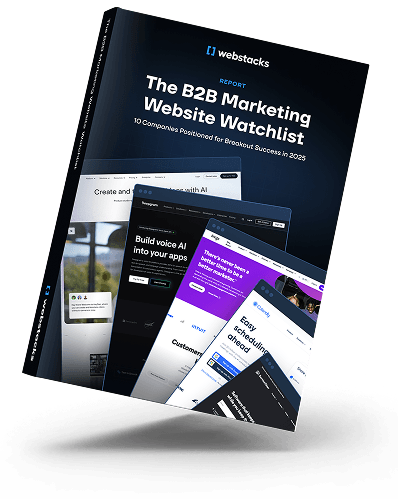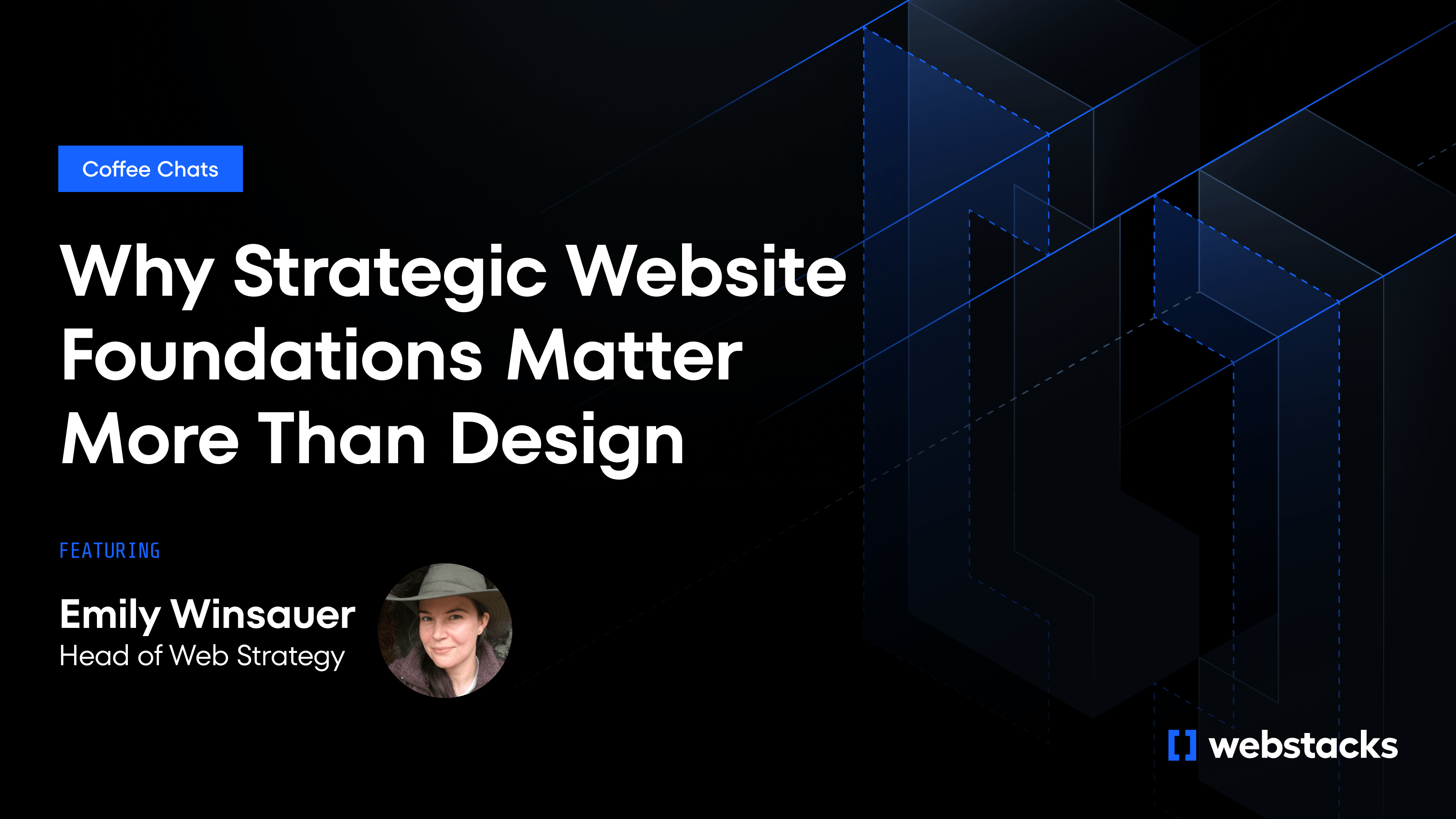Figuring out how to rank for B2B isn’t as straightforward as most SEO guides make it seem, mainly because most of them weren’t written for B2B in the first place.
While B2C and affiliate marketers focus on quick conversions and high-volume keywords, you're dealing with committee decisions, lengthy sales cycles, and five or six-figure deals. The game changes when so much more is on the line.
The vast majority of SEO content treats every website like an online store or blog. But your prospects aren't making impulse purchases. They're researching solutions, building business cases, and working through complex approval processes. They need specific content at each stage. Your SEO strategy must address this reality to effectively rank in the B2B space.
At Webstacks, we approach websites as performance products, not one-time projects. Your SEO strategy should drive measurable business growth, not just higher rankings. This guide provides a practical SEO approach specifically designed for B2B organizations.

1. Understand the B2B Search Environment
B2B search behavior differs from consumer search because you're targeting buying committees, not individual buyers. For example, when someone searches for enterprise software, they're researching on behalf of multiple stakeholders. Each has different priorities, concerns, and evaluation criteria.
This committee dynamic changes everything about your keyword strategy. You can't just optimize for product searches when the CFO cares about ROI, the IT director needs integration details, and end users want implementation timelines.
Your keyword strategy needs to cover every angle of the B2B buyer journey. These keyword categories drive the most results:
- Branded keywords capture searches for your company and product names when prospects already know about you.
- Solution-aware keywords target specific problems your product solves. "Customer churn reduction software" works better than generic "analytics platform".
- Integration-focused keywords address compatibility concerns, covering API documentation and platform connections.
- Bottom-funnel keywords capture comparison searches, pricing inquiries, and implementation questions that signal purchase readiness.
Prioritize research-based and solution-oriented terms over high-volume generic keywords. Industry-specific terminology and longer descriptive phrases that address concrete business problems convert better than broad terms.
Stop chasing search volume metrics. Focus on the questions your buying committee asks during evaluation. What keeps the CFO up at night? What technical requirements does IT need to validate? What business outcomes must the end-user team demonstrate?
B2B searchers want:
- Solutions to specific business challenges
- Educational content about industry problems
- Detailed comparisons between vendors
- Technical specifications and compatibility information
- Implementation guides and success roadmaps
When you align content with these genuine information needs, you create search experiences that move prospects through your funnel, not just generate traffic.
2. Build a Website Architecture That Supports SEO
Unlike consumer websites with simple product catalogs, your B2B site must accommodate multiple decision-makers, lengthy research processes, and intricate service offerings.
Clean, descriptive URL structures form your foundation. Skip generic URLs like "/page-1" or "/services". Instead, use: "/marketing-automation-integration" or "/enterprise-security-solutions" that immediately signal purpose to both users and crawlers.
Your content hierarchy should mirror how prospects think about and research solutions. Strategic navigation menus must prioritize the paths that matter most to your buying committee, not just what looks organized internally.
The pillar page strategy becomes particularly powerful for B2B by connecting main topics to related subtopics. Map pillar pages to key personas and journey stages. This creates comprehensive hubs for solutions, use cases, and integrations that establish authority.
Elements of effective B2B website architecture include:
- Category pages that serve as natural landing spots for broader search queries while helping distribute authority throughout your site
- Logical content grouping that aligns with how buying committees evaluate options
- Clear user pathways that guide different stakeholders to their specific information needs
- Resource hubs organized by solution area, industry, or use case
- Technical documentation that satisfies the due diligence requirements of enterprise buyers
Your internal linking strategy should distribute page authority across your website while connecting related content with descriptive anchor text. This creates a web of relevance that reinforces expertise and guides prospects through their research journey without requiring them to start over at your homepage every time.
3. Prioritize Technical SEO to Rank Higher in B2B
Most B2B sites have similar issues: slow load times, broken mobile experiences, orphaned pages, and missing schema markup. Decision-makers abandon research sessions when pages load too slowly. Your valuable content becomes invisible without proper technical optimization. Search engines can't find disconnected pages. These issues undermine even the best content strategy.
Start by tackling Core Web Vitals. These performance metrics directly impact user experience and rankings. Here's what to focus on:
- Largest Contentful Paint (LCP): Optimize images and reduce server response times
- First Input Delay or Interaction to Next Paint (FID/INP): Clean up JavaScript execution
- Cumulative Layout Shift (CLS): Properly size images and videos to prevent page jumps
Your site must work flawlessly across all devices. Mobile responsiveness matters even when your audience is predominantly desktop-based. Google treats mobile optimization as a ranking factor, and business professionals research on mobile between meetings or during commutes.
Next, implement schema markup to help search engines understand and elevate your content:
- Organization schema for company information
- Product schema for solutions
- FAQ schema for common questions
- HowTo schema for implementation guides
Use a composable architecture to support modular content creation. It helps you adapt fast to algorithm changes without replatforming, and gives your marketing team more control to optimize at scale.
4. Align SEO With GTM Goals (Not Just Content Production)
Integrate organic efforts directly into Go-To-Market strategies. Demand generation, product launches, and account-based marketing campaigns should work as one unified system. This alignment ensures your visibility efforts directly support revenue objectives. Every ranking improvement should move prospects closer to conversion.
Start by mapping your SEO strategy to the buyer journey:
- Early-stage: Focus on education — blog posts, guides, explainer videos.
- Mid-stage: Build trust with use cases, comparison pages, and solution overviews.
- Late-stage: Create frictionless paths to demos, pricing, and product specs.
Use structured data and schema markup to give search engines the full picture and make your business case clear in the SERP.
5. Create Content That Helps You Rank and Drive Pipeline
Your B2B strategy should prioritize content that actively moves prospects through the sales funnel. Generic blog posts won’t cut it.
Focus on high-impact formats like:
- Implementation guides
- Product comparisons
- Case studies with measurable results
- White papers and research reports
- Technical documentation that reduces friction
- ROI calculators to build the business case
- Webinars that humanize your solution
Each resource should solve a specific problem or answer an important question at a specific stage in the buyer journey. Don’t aim for volume. Instead, build a lean library of conversion-ready assets that support how your prospects evaluate solutions.
Design content and CTAs for the entire buying committee:
- Technical evaluators need detailed specifications and integration guides
- Financial decision-makers require ROI calculators and pricing information
- End users want to understand day-to-day functionality and benefits
Guide each persona to the next logical step — whether that’s a whitepaper, a webinar sign-up, or a trial. B2B conversions don’t always happen fast, but the right content gets you on the shortlist. Include credibility signals, such as customer logos, certifications, or benchmarking data, to reinforce trust.

6. Use Scalable Systems to Avoid SEO Bottlenecks
Traditional CMS setups stall growth. Every update requires a developer ticket. Every page launch needs IT approval. Your team spots a trending topic but remains stuck waiting for the next dev sprint, and by then, the moment’s gone.
The solution? Give your marketing team control over creation and optimization. Composable architecture makes this possible through modular, pre-built components that snap together like building blocks.
Instead of coding pages from scratch, your team assembles what they need from existing modules, such as landing pages, comparison charts, and integration guides, without touching a line of code.
This modular approach delivers immediate outcomes:
- Launch pages in hours, not weeks
- Test new layouts or CTAs on the fly
- Respond to algorithm updates in real-time
- Scale content without overloading your dev team
When you're not dependent on engineers for basic work, you respond to market changes in real-time instead of weeks later.
The right CMS makes this transformation possible through:
- Built-in SEO tools
- Marketer-friendly interfaces
- Analytics integrations
- Direct control over meta tags and on-page elements
B2B companies benefit most from this flexibility because they serve multiple stakeholder audiences with complex needs. You can create personalized experiences for different buyer personas while maintaining consistent standards across touchpoints.
This is exactly what Webstacks helps teams do. Our composable web design solutions give marketers full control of their digital presence, so they can move faster, iterate freely, and drive SEO results without waiting on dev.
7. Measure What Matters and Iterate
The best B2B SEO strategies don’t stop at rankings. They track what actually drives growth. Focus on four metric categories that tie directly to business outcomes:
- Organic visibility: Track traffic growth, keyword rankings (especially for non-branded terms), and share of voice. These show whether your content is showing up where your buyers are searching.
- Conversions and pipeline impact. Measure lead conversion rates from organic, lead quality scores, and customer acquisition costs.
- Engagement signals. Metrics like time on page, pages per session, and resource downloads reveal how well your content resonates with decision-makers and nudges them through the funnel.
- Technical health: Monitor Core Web Vitals, crawl stats, and indexation. These are the foundations of sustainable organic growth.
But measurement alone isn’t enough — continuous iteration is where the real gains happen. Run A/B tests on headlines, page layouts, and CTAs. Refresh stale content. Compare performance against competitors. Small experiments uncover what drives conversions, not just what looks good on a dashboard.
Use those insights to:
- Reprioritize your content calendar
- Fix underperforming pages
- Strengthen topical authority
- Close keyword and content gaps
In B2B, agility wins. The highest-performing teams treat SEO like a product: test, learn, improve, and repeat. Tie every iteration back to pipeline growth, and you'll stay ahead of competitors stuck chasing traffic alone.
The Fastest Way to Rank in B2B Is to Build the Right System
Ranking in B2B isn’t about flooding Google with content or chasing trends that don’t map to your buyers. You need to create a system that aligns with how your prospects research, evaluate, and buy. That system should also evolve as your go-to-market strategy evolves.
Most B2B SEO strategies treat websites like static brochures instead of dynamic growth engines. But when your site is built to scale, optimized to perform, and structured around your GTM motion, SEO becomes more than a traffic driver. It becomes a pipeline driver.
At Webstacks, we help B2B teams build websites that do just that. Not just rank, but convert, and not just educate, but accelerate deals.
We helped ServiceTitan migrate to a modular, composable setup that empowered their marketing team to launch content faster and grow visibility without dev bottlenecks. For Calendly, we built a scalable content system that supported their expansion into new verticals and drove sustained organic growth.
Ready to turn your website into a revenue-generating asset? Let's talk.




